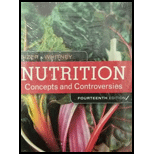
Bundle: Nutrition: Concepts and Controversies, Loose-leaf Version, 14th + LMS Integrated for MindTap Nutrition, 1 term (6 months) Printed Access Card
14th Edition
ISBN: 9781337127547
Author: Frances Sizer, Ellie Whitney
Publisher: Cengage Learning
expand_more
expand_more
format_list_bulleted
Question
Chapter 6, Problem 3SC
Summary Introduction
Introduction:
Proteins are complex macromolecules that are vital for the several different biological processes in the human body. Proteins are composed of amino acids, as building blocks or monomeric units. An amino acid has a carboxyl, an amino group, and an R group.
Expert Solution & Answer
Want to see the full answer?
Check out a sample textbook solution
Students have asked these similar questions
True / False:
β-bends can link together α-helices and β-sheets.
What is the major difference between tertiary and quaternary protein structure?
The sequence of amino acids involved.
The involvement of R (radical) groups.
The number of polypeptides involved.
The side chain of arginine contains a—
hydroxyl group.
carboxyl group.
ether group.
aldehyde group.
guanidino group.
Chapter 6 Solutions
Bundle: Nutrition: Concepts and Controversies, Loose-leaf Version, 14th + LMS Integrated for MindTap Nutrition, 1 term (6 months) Printed Access Card
Ch. 6 - Prob. 1RQCh. 6 - Prob. 2RQCh. 6 - Prob. 3RQCh. 6 - Prob. 1CTCh. 6 - Prob. 2CTCh. 6 - The basic building blocks for protein are a....Ch. 6 - Prob. 2SCCh. 6 - Prob. 3SCCh. 6 - Some segments of a protein strand coil, somewhat...Ch. 6 - Prob. 5SC
Ch. 6 - Prob. 6SCCh. 6 - Prob. 7SCCh. 6 - Prob. 8SCCh. 6 - Prob. 9SCCh. 6 - Prob. 10SCCh. 6 - Prob. 11SCCh. 6 - The following are complementary proteins: pot...Ch. 6 - Prob. 13SCCh. 6 - Prob. 14SCCh. 6 - Prob. 15SCCh. 6 - Prob. 16SCCh. 6 - Prob. 17SCCh. 6 - Prob. 18SCCh. 6 - Prob. 19SCCh. 6 - Prob. 20SC
Knowledge Booster
Learn more about
Need a deep-dive on the concept behind this application? Look no further. Learn more about this topic, health-nutrition and related others by exploring similar questions and additional content below.Similar questions
- This image shows the tertiary structure of a protein segment. Tertiary structure results from different interactions, or forces, between groups. Move the example of each force to the appropriate description on the protein. Then, identify the major force controlling tertiary structure. (Need help) It says I'm wrong.arrow_forwardAffinity and specificity of protein-protein interactions are mainly mediated by many weak chemical bonds such as: Group of answer choices van der Waals forces hydrogen bonds hydrophobic interactions all of the abovearrow_forwardAttach an amino acid monomer below. Name of the amino acid: Abbreviated name: Letter symbol:arrow_forward
- After denaturation of a tertiary protein like lysozyme (with one polypeptide chain), the only remaining bonds between its monomer subunits will be: the disulfide bonds the van der Waals forces the peptide bonds the hydrogen bonds the ionic bondsarrow_forwardDrag the correct amino acid into the corresponding box according to the roles they play. Reset Help Cycteine Proline Methionine First amino acid used in protein synthesis Forms kinks in the polypeptide forms disulfide bonds to stabilize backbone protein tertiary and quaternary structurearrow_forwardOptions are the same for the next slot.arrow_forward
- Drag each of the following items into the corresponding boxes to indicate the protein structural level that is predominantly affected by the chemical interactions listed. Some items may be placed in more than one box. Reset Help Hydrogen bonds between polar groups in amino acid side chains Hydrophobic interactions between amino acid side chains lonic bonds between positively- charged and negatively-charged amino acid side chains Peptide bonds Hydrogen bonds between carbonyl oxygens and amino nitrogens within a polypeptide backbone Disulfide bonds Primary structure Seconday structure Tertiary structure Quaternary structurearrow_forwardWhich of the following factor(s) may contribute to the stability of folded protein structures? Disulfide bonds. Hydrophobic effect. Electrostatic interactions. Hydrogen bonds. All of the above.arrow_forwardLinus Pauling’s a-helix structure (found in hemoglobin, myoglobin, actin, myosin, and keratin) is one of the most common examples of which level of protein organization? the quaternary structure the tertiary structure the secondary structure the primary structure all of the abovearrow_forward
- A peptide bond... is a version of an ester bond is a version of an amide bond is the basis of protein secondary structure is formed by addition of waterarrow_forwardAll of the following are considered "weak" interactions in proteins except: disulfide bonds. van der Waals forces. hydrogen bonds. hydrophobic interactions. ionic bonds.arrow_forwardThe disulfide bonds that make up the tertiary structure of proteins are stabilized by hydrogen bonds. Select one: True Falsearrow_forward
arrow_back_ios
SEE MORE QUESTIONS
arrow_forward_ios
Recommended textbooks for you
 Biology Today and Tomorrow without Physiology (Mi...BiologyISBN:9781305117396Author:Cecie Starr, Christine Evers, Lisa StarrPublisher:Cengage Learning
Biology Today and Tomorrow without Physiology (Mi...BiologyISBN:9781305117396Author:Cecie Starr, Christine Evers, Lisa StarrPublisher:Cengage Learning

Biology Today and Tomorrow without Physiology (Mi...
Biology
ISBN:9781305117396
Author:Cecie Starr, Christine Evers, Lisa Starr
Publisher:Cengage Learning
GCSE Chemistry - Acids and Bases #34; Author: Cognito;https://www.youtube.com/watch?v=vt8fB3MFzLk;License: Standard youtube license